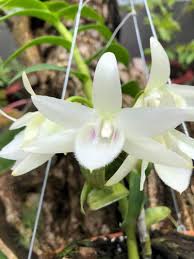# Volunteer Activities Related to Phalaenopsis Orchids

## Table of Contents
1. **Introduction**
2. **Understanding Phalaenopsis Orchids**
– 2.1. Characteristics and Significance
– 2.2. Cultural Importance
3. **The Role of Volunteers in Orchid Conservation**
– 3.1. Conservation Efforts
– 3.2. Education and Awareness Campaigns
4. **Community Gardening Initiatives**
– 4.1. Community Orchids Gardens
– 4.2. Local Schools and Educational Programs
5. **Workshops and Training Sessions**
– 5.1. Orchid Cultivation Workshops
– 5.2. Sustainable Practices Training
6. **Research and Monitoring Programs**
– 6.1. Data Collection and Surveys
– 6.2. Collaborating with Scientific Communities
7. **Promoting Biodiversity and Ecosystem Health**
– 7.1. Reforestation Projects
– 7.2. Habitat Restoration Initiatives
8. **Fundraising and Support for Orchid Conservation**
– 8.1. Organizing Events
– 8.2. Engaging with Local Businesses
9. **Global Volunteer Opportunities**
– 9.1. International Orchid Conservation Projects
– 9.2. Online Volunteering
10. **Challenges in Volunteer Activities**
– 10.1. Resource Constraints
– 10.2. Volunteer Retention
11. **Future Directions for Volunteer Involvement**
12. **Conclusion**
13. **FAQs**
—
## 1. Introduction
Phalaenopsis orchids, often referred to as moth orchids, are beloved for their stunning beauty and versatility. While they are widely cultivated for ornamental purposes, their conservation is essential for maintaining biodiversity and supporting ecosystems. Volunteer activities play a crucial role in promoting awareness, conservation efforts, and sustainable practices related to these exquisite plants. This article explores various volunteer opportunities and initiatives associated with Phalaenopsis orchids, emphasizing their importance in community engagement and environmental stewardship.
—
## 2. Understanding Phalaenopsis Orchids
### 2.1. Characteristics and Significance
Phalaenopsis orchids are known for their distinctive flower shapes and vibrant colors, making them popular among plant enthusiasts and collectors. They exhibit a range of colors, including white, pink, yellow, and purple, often adorned with intricate patterns. Their long-lasting blooms and ability to thrive in various conditions contribute to their widespread appeal.
### 2.2. Cultural Importance
In many cultures, orchids symbolize beauty, strength, and luxury. They are often used in traditional ceremonies, floral arrangements, and as gifts for special occasions. The cultural significance of Phalaenopsis orchids has led to their integration into various art forms, including painting and photography, further highlighting their impact on human expression.
—
## 3. The Role of Volunteers in Orchid Conservation
### 3.1. Conservation Efforts
Volunteers play an essential role in conservation efforts for Phalaenopsis orchids and other endangered species. These efforts include habitat restoration, invasive species management, and monitoring populations in the wild. By participating in conservation initiatives, volunteers contribute to the preservation of natural habitats and the overall health of ecosystems.
### 3.2. Education and Awareness Campaigns
Raising awareness about the importance of orchid conservation is vital for ensuring their future. Volunteers often engage in educational outreach programs, workshops, and community events to inform the public about the significance of Phalaenopsis orchids, their ecological roles, and the threats they face. These campaigns aim to inspire individuals to take action and participate in conservation efforts.
—
## 4. Community Gardening Initiatives
### 4.1. Community Orchids Gardens
Establishing community orchid gardens is an excellent way for volunteers to engage with their local communities while promoting the cultivation and care of Phalaenopsis orchids. These gardens provide a space for residents to learn about orchid care, share knowledge, and collaborate on gardening projects. They also serve as educational hubs, attracting visitors and promoting biodiversity.
### 4.2. Local Schools and Educational Programs
Volunteers can partner with local schools to introduce students to the world of orchids through hands-on gardening activities and educational programs. By creating orchid cultivation clubs or hosting workshops, volunteers can instill a sense of responsibility for nature and encourage students to appreciate the beauty of these plants. Such initiatives foster a connection to the environment and promote sustainable practices among younger generations.
—
## 5. Workshops and Training Sessions
### 5.1. Orchid Cultivation Workshops
Hosting orchid cultivation workshops allows volunteers to share their knowledge and skills with the community. These workshops can cover topics such as repotting, pest management, fertilization, and propagation techniques. By providing practical training, volunteers empower individuals to care for their orchids effectively and enhance their appreciation for these beautiful plants.
### 5.2. Sustainable Practices Training
Incorporating sustainable practices into orchid cultivation is essential for the long-term health of both the plants and the environment. Volunteers can organize training sessions focusing on organic gardening methods, water conservation, and responsible pest management. By equipping participants with sustainable techniques, volunteers contribute to a more environmentally friendly approach to orchid care.
—
## 6. Research and Monitoring Programs
### 6.1. Data Collection and Surveys
Volunteers can participate in research initiatives focused on monitoring Phalaenopsis orchid populations and their habitats. By collecting data on plant health, growth patterns, and environmental conditions, volunteers contribute valuable information to researchers and conservation organizations. This data can inform conservation strategies and help identify areas needing protection.
### 6.2. Collaborating with Scientific Communities
Collaboration between volunteers and scientific communities is essential for advancing orchid conservation efforts. Volunteers can assist researchers in field studies, providing manpower for data collection and analysis. This partnership fosters a deeper understanding of the challenges faced by Phalaenopsis orchids and supports informed decision-making in conservation planning.
—
## 7. Promoting Biodiversity and Ecosystem Health
### 7.1. Reforestation Projects
Many Phalaenopsis orchids thrive in forested environments, making reforestation projects an essential aspect of their conservation. Volunteers can participate in tree planting initiatives aimed at restoring natural habitats and promoting biodiversity. These projects not only benefit orchids but also support various wildlife species that rely on healthy ecosystems.
### 7.2. Habitat Restoration Initiatives
In addition to reforestation, habitat restoration initiatives focus on rehabilitating degraded areas. Volunteers can engage in activities such as removing invasive species, planting native flora, and creating buffer zones around sensitive habitats. These efforts contribute to restoring ecological balance and providing a conducive environment for Phalaenopsis orchids to thrive.
—
## 8. Fundraising and Support for Orchid Conservation
### 8.1. Organizing Events
Volunteers can organize fundraising events, such as orchid shows, plant sales, and community festivals, to raise money for orchid conservation initiatives. These events not only generate financial support but also serve as platforms for educating the public about the importance of orchid conservation and the need for sustainable practices.
### 8.2. Engaging with Local Businesses
Collaborating with local businesses can enhance fundraising efforts and create partnerships that benefit both the community and orchid conservation. Volunteers can seek sponsorships, donations, or in-kind support from businesses interested in promoting environmental initiatives. These partnerships help raise awareness and support for Phalaenopsis orchids while fostering a sense of community involvement.
—
## 9. Global Volunteer Opportunities
### 9.1. International Orchid Conservation Projects
For those interested in expanding their volunteer efforts beyond local initiatives, there are numerous international orchid conservation projects. Organizations and research institutions often seek volunteers to assist in fieldwork, habitat restoration, and educational outreach in various countries. These opportunities allow volunteers to contribute to global conservation efforts while gaining valuable experiences.
### 9.2. Online Volunteering
In addition to hands-on opportunities, online volunteering has become increasingly popular. Volunteers can engage in activities such as research, data entry, and social media management for organizations focused on orchid conservation. This flexibility allows individuals to contribute their skills and expertise from anywhere in the world.
—
## 10. Challenges in Volunteer Activities
### 10.1. Resource Constraints
Many volunteer initiatives face resource constraints, including limited funding, equipment, and materials. Addressing these challenges requires creativity and collaboration among volunteers, organizations, and community members. Finding innovative solutions, such as recycling materials or partnering with local businesses, can help overcome resource limitations.
### 10.2. Volunteer Retention
Maintaining volunteer engagement can be challenging, especially for long-term projects. Ensuring that volunteers feel valued and recognized for their contributions is essential for retention. Organizing regular appreciation events, providing ongoing training, and fostering a sense of community can help keep volunteers motivated and committed to their efforts.
—
## 11. Future Directions for Volunteer Involvement
As the need for orchid conservation becomes increasingly urgent, volunteer involvement will play a critical role in addressing environmental challenges. Future directions for volunteer activities may include:
– Expanding educational outreach to diverse communities to promote orchid conservation and sustainable practices.
– Developing partnerships with local governments and organizations to strengthen conservation efforts at regional and national levels.
– Exploring innovative technology solutions, such as mobile apps for monitoring orchid populations, to enhance volunteer engagement and data collection.
—
## 12. Conclusion
Volunteer activities related to Phalaenopsis orchids are vital for promoting conservation, educating communities, and fostering a deeper appreciation for these beautiful plants. By engaging in various initiatives, volunteers contribute to the preservation of biodiversity and the health of ecosystems. As the demand for environmental stewardship grows, the involvement of passionate individuals in orchid conservation will continue to make a meaningful impact on the future of Phalaenopsis orchids and the natural world.
—
## 13. FAQs
**1. What are Phalaenopsis orchids?**
Phalaenopsis orchids, also known as moth orchids, are popular flowering plants known for their striking
beauty and long-lasting blooms.
**2. How can I get involved in volunteer activities related to orchids?**
You can start by researching local organizations or botanical gardens that focus on orchid conservation and reach out to them for volunteer opportunities.
**3. What skills are needed to volunteer for orchid conservation?**
While gardening and horticultural skills are beneficial, volunteers with various backgrounds, including education, research, and event planning, can contribute meaningfully.
**4. Are there any online resources for learning about orchid care?**
Yes, many organizations and websites offer online resources, including articles, videos, and forums where you can learn about orchid care and conservation.
**5. Can I participate in international orchid conservation projects?**
Absolutely! Many organizations offer opportunities for volunteers to engage in conservation efforts worldwide, providing a chance to make a global impact.

